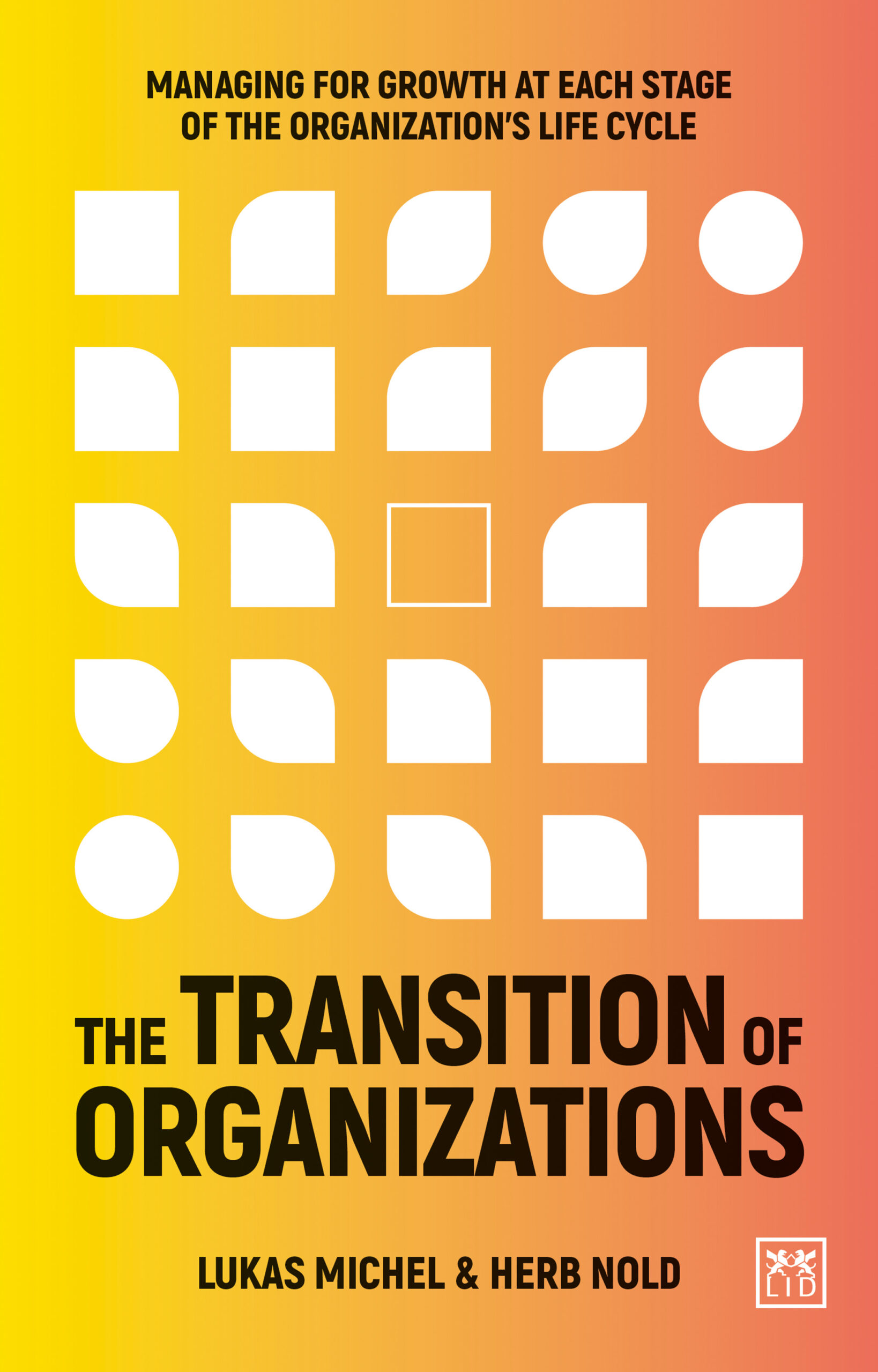|
Solving the Crisis of Red Tape with Lukas Michel & Herb Nold
Solving the Crisis of Red Tape

By Guest Contributors Lukas Michel & Herb Nold
Authors of The Transition of Organizations, Lukas Michel and Herb Nold, reveal how leaders can solve the crisis of red tape as their company grows into its fourth life cycle.
The Transition of Organizations is the result of 20 years of work with clients around the globe and the related research that enabled us to conclude that there are patterns of deliberate strategies companies can follow to overcome their inherent structural crises.
Organizational growth follows five life cycle stages: creativity, direction, delegation, coordination, and collaboration. Every stage comes with specific evolutionary and revolutionary attributes, followed by a crisis or organizational challenge that must be overcome to advance to the next stage. We evaluate organizations by looking at their structure through the lens of viewing management as a competitive advantage. Mapping management patterns using the Leadership Scorecard tool allows us to identify the dominant management style for each life cycle stage.
More on the GROWTH LIFE CYCLES
The coordination stage. Continued growth leads to the emergence of segmented organizations with specialized functions and lines of businesses that require coordination by top management. Sophisticated control mechanisms are introduced that allow leaders to understand what is going on in segments that are increasingly distant, organizationally and physically. Senior executives are able to take action when needed to keep all parts of the organization on track. Increased distance between leadership and business segments typically results in an environment that reduces trust between headquarters and business segments. In this coordination stage, the crisis of red tape arises as management introduces processes and procedures intended to keep them in the loop with organizations that have become too big and complex. Agile organisation solves the crisis of red tape. The purpose is to build collaboration capabilities.
The segment organisation. The organization is now large, mature, and complex. The company has sizeable specialized functional departments, several divisions, and competes in multiple product markets. To align the span of control, executives typically group the disparate units into larger market-based sectors that cluster similar business by product, region or customer. New staff groups are created to manage the increasingly important management system for planning, asset deployment and resource allocation. Staff specialists ensure that strategic criteria are consistent across the organizations, and that appropriate performance hurdles are being consistently met. Over time, a complex web of procedures requiring approval from upper-level executives or powerful headquarters specialists is created. Business unit managers must now obtain approval before embarking on any major strategy commitment or allocation of resources. The resulting procedural hurdles — frustrating, energy-sapping red tape — typically have the unintended consequence of slowing down the decision-making process, which inhibits the organizational ability to react quickly to opportunities or threats. Innovation may be limited and opportunities missed, while potential problems become real threats.
Crisis or red tape. Over time, as central staff groups at the home office become more powerful, yet another crisis occurs. This time, it is the crisis of red tape. Most readers who have worked for large, segmented companies will recognize the web of processes, procedures, policies, and approvals that characterize this crisis. Upper-level executives feel a need to add layers of procedures, so they have a sense of control, while lower-level operating managers feel that the decision-making process has become burdensomely slow. A great deal of time is devoted to meetings, to set and review strategy, allocate resources, and evaluate segment performance. Slowed reaction time, missed opportunities, and stifled innovation characterize the crisis of red tape in the coordination stage of growth.
Agile organisation. The fourth transition is the move from the coordination stage to the collaboration stage of growth. The networked organization emerges at this stage. The networked organization connects the various business segments with external business partners in the supply chain, or one of many strategic relationships, like partnerships or joint ventures. The key to making this move is to solve the crisis of red tape. As the organization grows and becomes increasingly complex and segmented, executives implement vast numbers of policies, procedures and processes designed to facilitate control and coordination.
Many of us who have worked in large, complex organizations have experienced the crisis of red tape, where it takes volumes of documentation moving through multiple levels of approvals to get anything done. The red tape is not only frustrating to workers on the front line, but it slows the organization’s ability to react or adjust to unusual or changing situations. Solving the crisis of red tape requires the organization to adopt a capabilities-base mode of operating, with an emphasis on a common purpose, effective collaboration, healthy relationships, and learning, to support the many actors attempting to navigate procedure-driven, network-type structures.
Solving the crisis of red tape. Moving from a segmented to a networked organization requires capabilities-based management with a focus on purpose, collaboration, relationships, and learning. These four elements require distinct strategies to transition from traditional management structures and techniques to agile management.
Management modes group bundles of managerial principles and capabilities into four categories, represented by the four quadrants of the square. Agile management principles enable the organization to sense and anticipate changes in the environment, proactively adapt, and manage changes that yield superior performance in the new environment. Agility helps people perform at their peak and value is created despite ongoing changes.
To solve the red tape crisis, agile management uses four strategies that guide leaders to reach their flow line by creating meaning through purpose, connecting knowledge through relationships, navigating ecosystems through collaboration, and learning through experience. Learning helps people work on the system rather than in or against the system.
Agile management requires the application of people-centric management techniques and the development of dynamic capabilities. The attributes of the Leadership Scorecard in a specific work environment and the dominant operating mode help leaders build agile capabilities to resolve the crisis of red tape that accompanies complexity.
Developing dynamic capabilities is the solution to operating in a network-type organization, where collaboration across national, cultural, legal, and other lines becomes essential. The many, varied players need to establish shared meaning that provides a common basis for people to cooperate and generate sustained growth.
In a dynamic environment, with critical knowledge widely distributed throughout the network, the capabilities-based mode dominates. Dynamic systems provide the means for executives to effectively practice people-centric management (the end) so that people throughout the network operate in a state of flow.
Building collaboration capabilities. Four capabilities — purpose, collaboration, relationships, and learning — are the means to operate in a networked organization. Once developed, these capabilities support people as they navigate through networks and ecosystems.
Solving the red-tape crisis has four parts: shared purpose, healthy relationships, close collaboration, and continuous learning. Each element requires the development of a distinct operating environment, with a distinct culture, distinct leadership, and distinct systems. All of these emerge and coalesce, triggering four fundamental shifts, if we combine agile, people-centric, and dynamic systems principles.
Purpose. The goal of the organization shifts from making money to delighting the customer or serving some greater social good. The role of the manager at this stage is to help people find purpose and higher meaning in what they do, rather than telling them what to do. Individual motivation becomes intrinsic rather than extrinsic.
Relationship. The relationship between individuals and their direct manager shifts to teams with delegated responsibility. With is pivot, the role of the manager is to offer direction and create a supportive work environment, not to check on people’s work. The manager becomes more of a coach than a commander.
Collaboration. Instead of work being coordinated by bureaucracy with rules, plans, and reports, work is coordinated by self-organizing teams using agile approaches. Teams of self-responsible individuals reach out to other teams to collectively establish their own rules of engagement and norms.
Learning. Rather than preoccupation with goals, efficiency and predictability, teams rely on transparency, ongoing learning, and knowledge sharing, and strive for continuous improvement. These attributes help teams maintain focus on what matters and tasks that add value.
Collaboration resolves the crisis of red tape. The transition from coordination to collaboration demands the development of three capabilities and capabilities-based management. Management techniques that emphasize purpose, collaboration and relationships help solve the tension between traditional and agile management and the next crisis.
Segment organizations require coordination by top management through a sophisticated control mechanism. Complex webs of processes, procedures and policies evolve, intended keep headquarters executives informed on what is going on in the segments, so they can step in with corrective actions if the segment wanders from the corporate strategy. Burdensome approval processes degrade responsiveness and stifle innovation. The crisis of red tape arises with increasing size and complexity as the home office attempts to coordinate the various segments through processes and procedures. Further growth comes from agile organisation that establish better collaboration capabilities.
What can you do?
- Collaborate through purpose and relationship.
- Review your organization’s collaboration capabilities.
- Activate a capabilities-based management mode.
- Navigate through networks and ecosystem with the right work environment.
Key words: coordination – The segmented organisation – crisis of red tape – agile organisation (Solving the crisis of red tape), building collaboration capabilities (Four shifts).
————————————————————————————————————————————————
Bibliography: Greiner, L. E. (1998). Evolution and Revolution as Organizations Grow. Harvard Business Review: Mai-June.
ABOUT THE AUTHOR

Suggested Reading
 The Transition of Organizations explores various common patterns of management styles and then offers transition strategies to help managers succeed in the digital economy. The authors guide leaders to prepare for these transitions by laying the foundations or infrastructure needed to prevent a crisis that inhibits further growth. They also provide leaders with a greater understanding of the growth framework, which will help leaders to manage better the development of their companies.
The Transition of Organizations explores various common patterns of management styles and then offers transition strategies to help managers succeed in the digital economy. The authors guide leaders to prepare for these transitions by laying the foundations or infrastructure needed to prevent a crisis that inhibits further growth. They also provide leaders with a greater understanding of the growth framework, which will help leaders to manage better the development of their companies.

